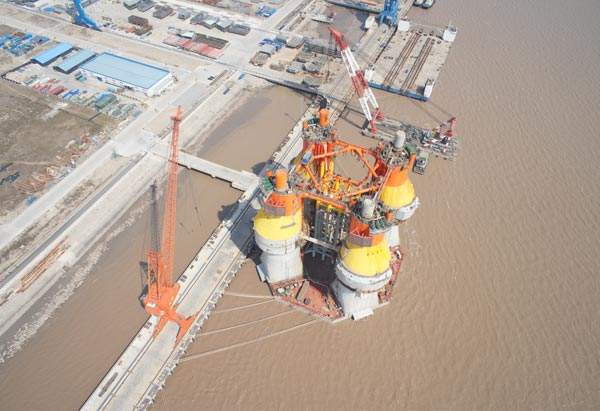Cheviot production platform is a semi-submersible drilling, production and storage facility being fabricated for the development of the Cheviot offshore field. The field is owned by ATP Oil & Gas (ATP). The Cheviot deep-water platform will be deployed approximately 62 miles east of the Shetland Islands, in 550ft of UK North Sea waters.
The platform can be flexibly used for dry-tree completions as well as steel catenary risers (SCRs).
Construction on the platform commenced in 2008 and is expected to be completed in 2013. First production from the Cheviot field is set to begin in 2014.
Bluewater Industries is the engineering, procurement and construction management (EPCM) contractor for the production platform.
Unique Octabuoy concept for ATP’s deep-water platform
The hull form of the Cheviot production platform is based on Moss Maritime’s Octabuoy concept of a dry-tree semi-submersible platform. Its design is based on established semi-submersible technology and is well suited for dry well-heads and SCRs.
The platform’s octagonal-shaped columns provide better motion characteristics compared to other floating platforms being used for dry-tree oil and gas production. Another unique feature of the platform is its innovative taut-leg mooring system. The turret can be made to drop away from the bottom of the hull.
Octabuoy will provide oil storage in the hull and offer drilling as well as workover options. The platform can be deployed at multiple fields, thereby amortising the platform costs over multiple fields. It will have a useful life of approximately 50 years.
Structure of the Cheviot production platform
Cheviot platform will have an octagonal ring-shaped pontoon. The two deck sponsons will be supported by four columns. The height of the lower hull will be around 272ft. Height of the pontoon will be approximately 40ft and height of the deck structure will be about 26ft.
The main deck area will be about 66,736 square feet with a topside weight capacity of 28,000t, including the deck structure.
The platform’s lower hull will be used to accommodate pump rooms, ballast, bulk mud and cement tanks. It will also be used to set-up tanks for other purposes such as fuel, drill water, potable water, brine and base oil.
Design of the semi-submersible drilling, production and storage facility
With its Octabuoy design concept, Moss Maritime aims to obviate costs associated with far-shore installation and commissioning of the platform. The main objectives behind using by the Octabuoy concept were to provide better pitch and roll motions to do away with riser fatigue and achieve maximum flexibility by providing topsides weight capacity and deck area.
Design of the platform was started in 2000. St. Petersburg-based Krylov Shipbuilding Research Institute was approached by Moss Maritime to fine-tune the platform’s hull parameters and stability. The designers gave more stress on eliminating second-order roll and pitch motions so the unit can support SCRs and above-water trees, even in rough weather and harsh sea conditions.
Development of ATP Oil & Gas’s Cheviot deep-water platform
The hull of the Cheviot platform is being manufactured by COSCO at its Nantong Shipyard in China. COSCO is also responsible for building the utility deck. The topside processing module is being constructed in the US. Once completed, the processing unit will be transported to China, where it will be mated with the utility module.
The completed hull will be shipped to Norway and stored there until the utility deck and topside processing module are mated. This part of the project will be undertaken by Bergen Group, as part of a subcontract signed with Bluewater Industries in October 2011.
The potable water solution onboard the Cheviot platform will be provided by Salt Separation Services.
Mechanical and electrical equipment used on the North Sea-based facility
ATP’s Cheviot oil and gas platform will be equipped with integrated mechanical and electrical equipments supplied by Siemens.
The platform’s topsides solution will comprise generator sets, compression, an electrical building, electricity distribution system, integrated control and safety system (ICSS) for process and safety control, plus a telecommunications system.
Siemens’ supply package calls for an electrical building, a pair of SGT-300 gas-turbine-driven generator sets and two SGT-200 gas-turbine-driven tandem STC-SV compressors.
The electricity distribution system will be comprised of medium and low voltage switch-gears, frequency drives of varying capacity and UPS.
The platform will also be provided with Siemens’ produced water treatment systems which will work on hydro-cyclone and gas floatation technology.










